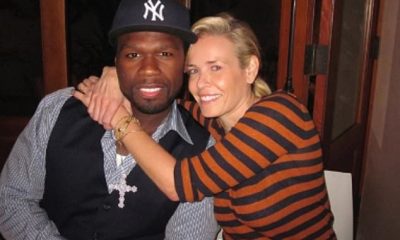Entertainment
Film Review: ‘Fast & Furious 7’
By Dwight Brown
NNPA Film Critic
Walking into a theater to see the latest Fast & Furious episode is like saying hello to an old, well-oiled friend. Great and familiar cast, excellent script, superb production values and the direction is tight as a drum. Can’t say this is the best film of the franchise, because so many of them have been excellent. But it’s easily the most daring. Fasten your seat belts and test the airbags. This one accelerates real fast.
Deckard Shaw (Jason Statham), a British black ops assassin, has a bug up his butt. Dominic Toretto (Vin Diesel) and his crew killed his brother and he is out for revenge. First stop is the office of CIA agent Luke Hobbs (Dwayne Johnson), where Shaw and Hobbs get into a fight that leaves the hulky agent broken. Next Shaw sends his blessings in the guise of a bomb to Dominic, his pal Brian (Paul Walker), his lady Mia (Jordana Brewster) and their kid. Kaboom!
Dom seeks answers. A government operative (Kurt Russell) has a plan. If Dom and his “family” hunt down a beta device called a Gods Eye, which is capable of tracking down anybody through aggregated surveillance cameras and audio feeds—even from cell phones, he’ll let them use it to catch Shaw. Says the operative, “It’s like a tracking device on steroids.” Says its inventor, Ramsey (Nathalie Emmanuel), “it uses every camera eye and audio device in this hemisphere.” And off they go, into battle. Dom and his crew and their vehicles. To the mountains of Eastern Europe, to Japan, the Middle East and L.A.
Director James Wan (Saw and The Conjuring) steps up to the camera along side cinematographers Marc Spicer and Stephen F. Windon (Fast & Furious 6) and displays an exceptional dexterity for car chases, fistfights and brawls. He uses a lot of close ups, and that filmmaking strategy drags you into the characters, their actions and the movie. With the aide of editors Leigh Folsom Boyd, Dylan Highsmith, Kirk M. Morri and Christian Wagner, he assembles adrenalin-pumping footage that is near perfectly paced for 140 minutes.
The action sequences are spellbinding. Cars jump out of planes, roll down mountains, are pummeled by missiles and skid through buildings. The car crew jumps out of moving trucks onto cars, drive super charged classic cars and evade gunshots. Punches are thrown, tire irons swung and machine guns are wielded around like toys. There is a precision to the proceedings that is astounding, invigorating and over the top.
Screenwriter Chris Morgan, who penned four previous chapters, knows the drill. Personal drama (there are some awkward sentimental moments that linger too long), romance (Diesel and Michelle Rodriguez rekindle the love story between Dom and Letty), intrigue, revenge, evil doings, retribution and the final fight and chase scenes. He doesn’t let the characters evolve much, compared to the originally one conjured by Gary Scott Thompson in 2001. He’s more faithful to their personalities, relationships and group dynamics. There are millions of fans waiting for whiney Roman (Tyrese Gibson) to crack jokes and Tej (Ludacris) to have a tech solution for a problem, and Morgan doesn’t disappoint.
The direction, production elements and writing wouldn’t mean a thing if the cast wasn’t on their game, and they are. They’ve aged; fuller faces, softer muscles, and maybe they’ve slowed down a step or two. Diesel is laconic, strong, the alpha. Johnson has his customary bravura. Rodriguez has that perfect blend of strong Latina and vulnerable woman. Statham is a worthy villain. Kurt Russell is a welcome addition. If you didn’t know that Paul Walker had passed, you couldn’t guess from what’s on view that his work, stand-ins, his brother and movie magic filled out his entire role in the movie. It’s easy to see that this film is a homage to his spirit.
It’s hard to say this is the best action film every made, but worth that debate.
This spring when you walk into your theater to see Fast & Furious 7, you will walk out thinking you just saw the first blockbuster event movie of the summer – only it isn’t summer yet.
Wanna go for a ride?
Visit NNPA Film Critic Dwight Brown at DwightBrownInk.com.
Activism
Oakland Post: Week of May 7 – 13, 2025
The printed Weekly Edition of the Oakland Post: Week of May 7 – 13, 2025

To enlarge your view of this issue, use the slider, magnifying glass icon or full page icon in the lower right corner of the browser window.
Activism
Oakland Post: Week of April 30 – May 6, 2025
The printed Weekly Edition of the Oakland Post: Week of April 30 – May 6, 2025

To enlarge your view of this issue, use the slider, magnifying glass icon or full page icon in the lower right corner of the browser window.
Arts and Culture
BOOK REVIEW: Love, Rita: An American Story of Sisterhood, Joy, Loss, and Legacy
When Bridgett M. Davis was in college, her sister Rita was diagnosed with lupus, a disease of the immune system that often left her constantly tired and sore. Davis was a bit unfazed, but sympathetic to Rita’s suffering and also annoyed that the disease sometimes came between them. By that time, they needed one another more than ever.

By Terri Schlichenmeyer
Author: Bridgett M. Davis, c.2025, Harper, $29.99, 367 Pages
Take care.
Do it because you want to stay well, upright, and away from illness. Eat right, swallow your vitamins and hydrate, keep good habits and hygiene, and cross your fingers. Take care as much as you can because, as in the new book, “Love, Rita” by Bridgett M. Davis, your well-being is sometimes out of your hands.
It was a family story told often: when Davis was born, her sister, Rita, then four years old, stormed up to her crying newborn sibling and said, ‘Shut your … mouth!’
Rita, says Davis, didn’t want a little sister then. She already had two big sisters and a neighbor who was somewhat of a “sister,” and this baby was an irritation. As Davis grew, the feeling was mutual, although she always knew that Rita loved her.
Over the years, the sisters tried many times not to fight — on their own and at the urging of their mother — and though division was ever present, it eased when Rita went to college. Davis was still in high school then, and she admired her big sister.
She eagerly devoured frequent letters sent to her in the mail, signed, “Love, Rita.”
When Davis was in college herself, Rita was diagnosed with lupus, a disease of the immune system that often left her constantly tired and sore. Davis was a bit unfazed, but sympathetic to Rita’s suffering and also annoyed that the disease sometimes came between them. By that time, they needed one another more than ever.
First, they lost their father. Drugs then invaded the family and addiction stole two siblings. A sister and a young nephew were murdered in a domestic violence incident. Their mother was devastated; Rita’s lupus was an “added weight of her sorrow.”
After their mother died of colon cancer, Rita’s lupus took a turn for the worse.
“Did she even stand a chance?” Davis wrote in her journal.
“It just didn’t seem possible that she, someone so full of life, could die.”
Let’s start here: once you get past the prologue in “Love, Rita,” you may lose interest. Maybe.
Most of the stories that author Bridgett M. Davis shares are mildly interesting, nothing rare, mostly commonplace tales of growing up in the 1960s and ’70s with a sibling. There are a lot of these kinds of stories, and they tend to generally melt together. After about fifty pages of them, you might start to think about putting the book aside.
But don’t. Not quite yet.
In between those everyday tales, Davis occasionally writes about being an ailing Black woman in America, the incorrect assumptions made by doctors, the history of medical treatment for Black people (women in particular), attitudes, and mythologies. Those passages are now and then, interspersed, but worth scanning for.
This book is perhaps best for anyone with the patience for a slow-paced memoir, or anyone who loves a Black woman who’s ill or might be ill someday. If that’s you and you can read between the lines, then “Love, Rita” is a book to take in carefully.
-

 Activism4 weeks ago
Activism4 weeks agoOakland Post: Week of April 9 – 15, 2025
-

 Activism2 weeks ago
Activism2 weeks agoAI Is Reshaping Black Healthcare: Promise, Peril, and the Push for Improved Results in California
-

 Activism3 weeks ago
Activism3 weeks agoOakland Post: Week of April 16 – 22, 2025
-

 Activism2 weeks ago
Activism2 weeks agoNewsom Fights Back as AmeriCorps Shutdown Threatens Vital Services in Black Communities
-

 Activism2 weeks ago
Activism2 weeks agoBarbara Lee Accepts Victory With “Responsibility, Humility and Love”
-

 Activism2 weeks ago
Activism2 weeks agoFour Bills Focus on Financial Compensation for Descendants of Enslaved People
-

 Activism2 weeks ago
Activism2 weeks agoESSAY: Technology and Medicine, a Primary Care Point of View
-

 Activism2 weeks ago
Activism2 weeks agoFaces Around the Bay: Author Karen Lewis Took the ‘Detour to Straight Street’
















































